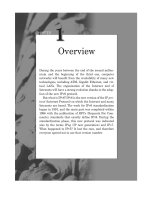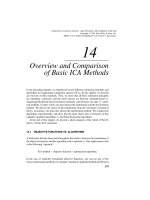Chapter+01+ overview
Bạn đang xem bản rút gọn của tài liệu. Xem và tải ngay bản đầy đủ của tài liệu tại đây (2.13 MB, 30 trang )
Cryptography and Network Security
1. Overview
Lecture
d by
Nguyễn Đức Thái
Outline
Security concepts
X.800 security architecture
Security attacks, services,
mechanisms
Models for network (access)
security
Network security terminologies
2
Outline
Khái niệm bảo mật
Kiến trúc an ninh X.800
Các cuộc tấn công an ninh, dịch
vụ, cơ chế
Mô hình cho (truy cập) an ninh
mạng
Thuật ngữ an ninh mạng
Computer Security Objectives
Confidentiality
• Data confidentiality
• Assures that private or confidential information is not made
available or disclosed to unauthorized individuals
• Privacy
• Assures that individuals control or influence what information related
to them may be collected and stored and by whom and to whom that
information may be disclosed
Integrity
• Data integrity
• Assures that information and programs are changed only in a
specified and authorized manner
• System integrity
• Assures that a system performs its intended function in an
unimpaired manner, free from deliberate or inadvertent
unauthorized manipulation of the system
Availability
• Assures that systems work promptly and service is not denied
to authorized users
4
Mục tiêu bảo mật máy tính
Confidentiality (Bảo mật)
• Bảo mật dữ liệu
Đảm bảo rằng thơng tin cá nhân hoặc bí mật không được cung cấp hoặc
tiết lộ cho các cá nhân trái phép
• Riêng tư
• Đảm bảo rằng các cá nhân kiểm sốt hoặc tác động những gì thơng
tin liên quan đến họ có thể được thu thập và lưu trữ và bởi ai và cho
ai thơng tin có thể được tiết lộ .
Integrity (Tính tồn vẹn).
• Tồn vẹn dữ liệu (Data integrity)
Đảm bảo thơng tin và các chương trình được thay đổi chỉ trong
một cách thức quy định và có thẩm quyền
• Hệ thống tồn vẹn (System integrity)
Đảm bảo rằng một hệ thống thực hiện chức năng dự định của
nó một cách ngun vẹn, miễn phí từ thao tác trái phép cố ý
hoặc vô ý của hệ thống
Availability (sẵn sang).
• Đảm bảo rằng các hệ thống làm việc kịp thời, dịch vụ không bị
từ chối cho người dùng hợp lệ.
5
CIA Triad (CIA Tam Hoàng)
Các yêu cầu an Tam Hoàng
6
Possible Additional Concepts
(Có thể xảy khái niệm bổ sung)
Authenticity
Accountability
•Verifying that
users are who
they say they are
and that each
input arriving at
the system came
from a trusted
source
•The security goal
that generates
the requirement
for actions of an
entity to be
traced uniquely to
that entity
7
Có thể xảy khái niệm bổ sung
Tính xác thực
• Thẩm định rằng người sử dụng là những
gì họ nói là và mỗi đầu vào đến tại hệ
thống đến từ một nguồn đáng tin cậy
Trách nhiệm
• Các mục tiêu an ninh đó tạo ra những
yêu cầu đối với các hành động của một tổ
chức được truy tìm chất riêng thực thể đó
Terms (thuật ngữ)
9
Security Attacks
A means of classifying
security attacks, used
both in X.800 and RFC
4949, is in terms of
passive attacks and active
attacks
A passive attack
attempts to learn or
make use of information
from the system but
does not affect system
resources
An active attack
attempts to alter system
resources or affect their
10
Passive Attacks
Passive attacks are in the
nature of eavesdropping on, or
monitoring of, transmissions.
The goal of the opponent is to
obtain information that is being
transmitted.
Two types of passive attacks are
i.
the release of message contents
and
ii. traffic analysis.
11
Active Attacks
Involve some modification
of the data stream or the
creation of a false stream
Difficult to prevent because
of the wide variety of
potential physical,
software, and network
vulnerabilities
Goal is to detect attacks
and to recover from any
disruption or delays caused
by them
Masquera
de
•Takes place when one
entity pretends to be a
different entity
•Usually includes one of the
other
forms of active attack
Repla
y
•Involves the passive
capture of a data unit and
its subsequent
retransmission to produce
an unauthorized effect
Modificati
on of
messages
Denial
of
servic
e
•Some portion of a
legitimate message is
altered, or messages are
delayed or reordered to
produce an unauthorized
effect
•Prevents or inhibits the
normal use or
management of
communications facilities
12
Passive Attacks - Interception
Release of message
contents
13
Passive Attacks – Traffic
Analysis
Observe traffic pattern
Traffic
analysis
14
Handling Attacks
Passive attacks – focus on
Prevention
• Easy to stop
• Hard to detect
Active attacks – focus on Detection
and Recovery
• Hard to stop
• Easy to detect
15
Security Services (X.800)
Authentication - assurance that
communicating entity is the one claimed
• have both peer-entity & data origin
authentication
Access Control - prevention of the
unauthorized use of a resource
Data Confidentiality – protection of
data from unauthorized disclosure
Data Integrity - assurance that data received
is as sent by an authorized entity
Non-Repudiation - protection against denial
by one of the parties in a communication
Availability – resource accessible/usable
16
Authentication
Concerned with assuring that a
communication is authentic
• In the case of a single message, assures
the recipient that the message is from the
source that it claims to be from
• In the case of ongoing interaction, assures
the two entities are authentic and that the
connection is not interfered with in such a
way that a third party can masquerade as
one of the two legitimate parties
Two specific authentication services are defined
in X.800:
• Peer entity authentication
• Data origin authentication
17
Access Control
The ability to limit and control the access
to host
systems and applications via
communications links
To achieve this, each entity trying to
gain access must first be identified, or
authenticated, so that access rights can
be tailored to the individual
18
Data Confidentiality
The protection of transmitted data from
passive attacks
• Broadest service protects all user data
transmitted between two users over a
period of time
• Narrower forms of service includes the
protection of a
single message or even specific fields
within a message
The protection of traffic flow from
analysis
• This requires that an attacker not be
able to observe the source and
destination, frequency, length, or other
19
Data Integrity
Can apply to a stream of messages, a
single message, or selected fields
within a message
Connection-oriented integrity service, one
that deals with a stream of messages,
assures that messages are received as
sent with no duplication, insertion,
modification, reordering, or replays
A connectionless integrity service, one
that deals with individual messages
without regard to any larger context,
generally provides protection against
message modification only
20









